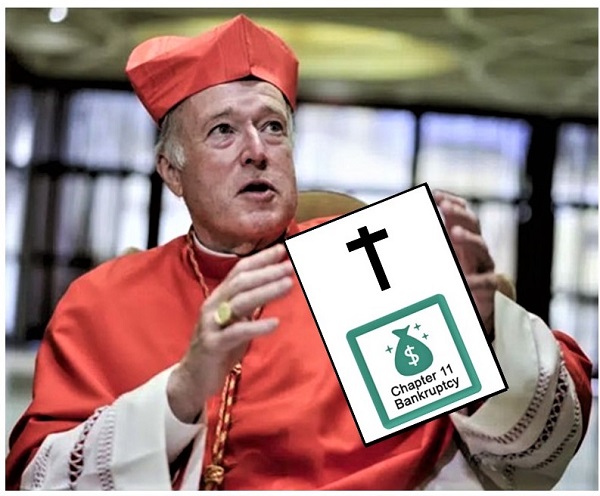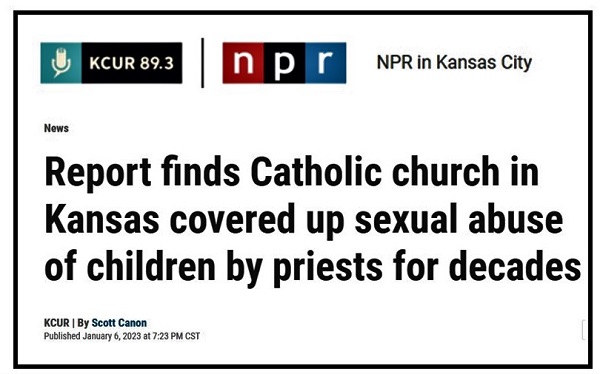Interspersed in this article are pictures of U.S. Catholic clergy who have been convicted of sexual abuse. While there apparently is no database that tracks these convictions, the most recent estimate I could find lists more than 6,400 U.S. priests or other Catholic Church personnel who have been accused of sexual abuse, and that only “three percent of all priests against whom allegations were made were convicted and about two percent received prison sentences.”
The above image is of Robert McElroy, Bishop of the San Diego Roman Catholic Diocese, holding the playbook referenced in the title of this post.
What prompted that image was this story:
On February 11, San Diego Union-Tribune readers were greeted with this front-page headline:

“The Roman Catholic Diocese of San Diego is warning it may have to file bankruptcy in the future because of the potential fallout from hundreds of pending lawsuits alleging sexual abuse by clergy over the past 75 years.”
The article noted this wasn’t the first time the Roman Catholic Diocese of San Diego filed for bankruptcy for the same reason:

“The warning comes nearly 16 years to the day since the diocese last sought the sanctuary of the bankruptcy code, filing for Chapter 11 reorganization in the face of 144 claims of sexual abuse by clergy. The bankruptcy was dismissed eight months later, after the diocese reached a settlement with the victims for $198 million.”
So, not the first time for this diocese, nor the first time for a U.S. diocese (or archdiocese or religious order) to file for bankruptcy in response to sexual abuse lawsuits.
Let’s go back to when this tragedy first became public.
It began with this, in January 2002:

The Boston Globe story spread across the country, and people began coming forward, talking about how they’d been abused by Catholic clergy. At the time of the abuse, many were male and female children, but male and female adults claimed abuse as well.
And the accusers weren’t just talking about their abuse by clergy. They were also talking to lawyers, and demanding justice.
So the church hierarchy put their red-beanied heads together…

And they also hired lawyers, and came up with a strategy:

A mere two years after the Boston Globe story, the first Catholic diocese filed for bankruptcy, according to this article:

“Archdiocese of Portland Oregon – filed 7/6/04 – $75 million settlement. At the time the archdiocese filed for bankruptcy, almost 170 people had filed suits alleging abuse.”
That same article lists – at #5:
“Diocese of San Diego, California – 2/27/07 – $198 million. 144 victims.”
And now the Diocese of San Diego may make the list again.

Going back to the Union-Tribune article, here’s one of the catalysts for this new slew of lawsuits:
“…the main driver behind a possible bankruptcy was the passage by the state Legislature in 2019 of AB 218, a law that reopened for three years a window for filing sexual abuse claims which occurred long ago and would otherwise be barred by legal deadlines. The law applied not only to churches but any organization. That window closed at the end of 2022.
“The law, which was signed by Gov. Gavin Newsom in October 2019, also contains a provision allowing a tripling of any monetary damages awarded if the organization was proven to have engaged in a cover-up.

“…the majority of the claims date from 50 to 75 years ago, and no cases have been filed alleging abuse by a clergy member this century. No current priests are named in the suits…”
In my research for this post I came across an organization called ChildUSA.org, whose website says:
“Our mission is to employ in-depth legal analysis and cutting-edge social science research to protect children, prevent future abuse and neglect, and bring justice to survivors.”
This led me to a 2021 report from ChildUSA.org that I think is worth quoting:
“Starting in 2004, Roman Catholic dioceses started to explore the use of Chapter 11 bankruptcy filings to deal with the many victims of the Catholic clergy sex abuse crisis. To date, 29 Archdioceses and dioceses have filed for Chapter 11.”
(That number of 29, according to the Bishop-Accountability.org website, is now 31 as of 12/2/22.)

“Resorting to bankruptcy when facing civil abuse liability for child sexual abuse (CSA)…now has become a preferred choice for institutions facing liability for CSA.”
“The bankruptcy system was not established with child sex abuse victims in mind. Chapter 11, in particular, exists to manage assets for an organization going through difficult times. The purpose of a Chapter 11 filing is to stay actions against a debtor and its property so that the value of the estate can be distributed to creditors in the orderly manner provided by the Bankruptcy Code.
“In a cruel, though unintended, irony in these CSA cases, the focus is on the well-being of the institution that covered up child sex abuse and on providing victims with as little financial compensation as possible.”
And that’s exactly what the Diocese of San Diego is once again contemplating – “providing victims with as little financial compensation as possible.”
The Union-Tribune article talks about attorney Irwin Zalkin, who represents about 120 of the 400 plaintiffs who have filed suits in San Diego Superior Court

Zalkin filed the first case, and it’s set to go to trial in July.
The Union-Tribune article explains.
“Filing for bankruptcy prompts an immediate halt to any lawsuits against the person or entity filing for bankruptcy protection. That stay remains in effect for the duration of the bankruptcy.
“If the diocese were to file in late spring or early summer, it would be similar to what happened in February 2007, when the diocese went into bankruptcy court just hours before a trial in the first of the 144 cases was set to begin. The trial never happened because the settlement resolved all the cases.”
“Resolved all the cases” – but “with as little financial compensation as possible.”
The Diocese of San Diego 2007 settlement was $198 million for 144 victims. That works out to an average of $1,375,000 per victim.

Which sounds like a lot of money, until you subtract substantial lawyers’ fees and possibly taxes…
And add in what can happen to the victims of clergy sexual abuse after they’ve bravely come forward, talked about the abuse, and are then subjected to “bankruptcy judges [who have no] training on the trauma inflicted on children by sex abuse or the details of sex abuse, sex trafficking, and organizational dysfunction in dealing with child sex abuse victims”:
“The result is the re-traumatization of many victims, either through the way the process works, or through the feeling of being re-victimized by the institution that caused their problems, which typically include depression, PTSD, substance abuse, failed relationships and marriages, and suicidal ideation, as well as suicide itself.
“Other difficulties for victims in the legal process can include challenges in acquiring evidence as well as experiencing emotional hardships such as shame, or mistrust of the judicial system.”
When you consider this kind of long-lasting – often permanent – damage…
That money awarded in 2007 to the 144 victims is a pittance.
Especially when you consider this February 2023 article:

“If you’re looking at the Catholic Church alone, ‘God’ has at least – and we’re putting a huge emphasis on ‘at least’ – $73 billion in assets.”
If the 400 plaintiffs who have filed suits now are awarded the same settlement as in 2007, the total bill would be in excess of $550 million.

Keven Eckery, the communications director for the Diocese of San Diego was quoted as saying,
“And frankly, we don’t have that kind of money.”
Tsk, tsk, Kevin.
Are you unfamiliar with the 10 Commandments, #9 of which is:
“Thou shall not bear false witness.”
This means:
Do not lie.
Eckery also said any bankruptcy filing would be so all people who claimed they were abused would be treated fairly.
“Treated fairly”?
Catholic clergy at all levels have done an immeasurable amount of damage to their victims, but instead of doing the right thing, the church is going to weasel out of as much responsibility as it possibly can.
So, Mr. Eckery, here’s your assignment: Pick up the chalk and write 100 times…

It’s hard to know who to feel sorriest for in this tragedy – the victims of sexual abuse…
Or the 1.3 million Roman Catholics who go to church in the 98 diocesan parishes in San Diego and Imperial counties. Who give their – in most cases – hard-earned money to the church…

…so the church can provide spiritual comfort and guidance, provide outreach to the poor and the marginalized, and do other good works.
Instead, in 2007 San Diego Catholic Church members saw their money go to this:

And today’s San Diego Diocese church members may soon see the same again.
During the first weekend in February the above pictured Bishop Robert McElroy sent a letter to parishioners, which said in part:

“…the Diocese must face the staggering legal costs of responding to these new lawsuits. In 2007, the Diocese paid out $198 million to settle 144 claims of abuse that had been brought during an earlier lifting of the statute of limitations. This depleted most of the assets of the Diocese. Even with insurance, the Diocese will not be able to pay out similar sums now. This challenge is compounded by the fact that a bill has now been introduced into the Legislature that seeks to eliminate the statute of limitations entirely, leaving the Diocese vulnerable to potential lawsuits forever.
“For all of these reasons, we may be facing a moment where the Diocese enters into bankruptcy in the coming months…
Did somebody say…
“Weasel”?
I call it like I see it.
And in the meantime, the hits just keep on coming.
Here’s one from last month:


